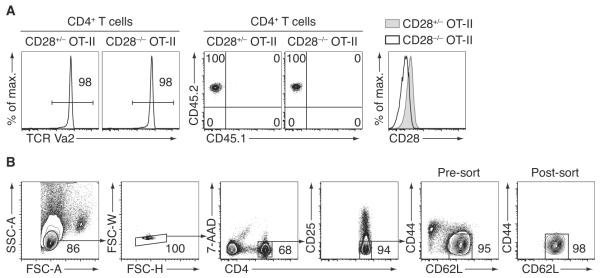Figure 1.

Isolation of naïve TCR-tg CD4+ T cells for adoptive transfer. (A) Single-cell suspensions were prepared from spleen and lymph nodes of CD28+/− or CD28−/− (Shahinian et al., 1993) OT-II TCR-tg mice. An aliquot was stained with PE-conjugated anti-CD4, APC-conjugated TCR Vα2, PerCP-Cy5.5-conjugated anti-CD45.2, eFluor450-conjugated anti-CD45.1, and FITC-conjugated anti-CD28 (clone 37.51) for verification of the phenotype of the donor cells. (B) The rest of the cells were pre-enriched for untouched CD4+ T cells by magnetic cell separation, followed by staining with antibodies against CD4 (conjugated to eFluor450), CD25 (APC), CD44 (Alexa Fluor 700), and CD62L (PE-Cy7). To exclude dead cells, 7-AAD was added to the stained cell suspension right before acquisition/sorting on a FACSAria II cell sorter (BD Biosciences). Small lymphocytes were gated by FSC-A vs. SSC-A characteristics. Singlet cells are identified by FSC-H vs. SSC-W gating (note that the use of EDTA in the sorting buffer significantly reduced doublet formation). Treg cells were then excluded by gating out CD25+ cells. Finally, naïve CD4+ T cells were sorted as CD62Lhigh CD44low/int cells. An optional re-sort on a small aliquot of the sorted cells was performed to verify the high purity of the obtained cell population.
